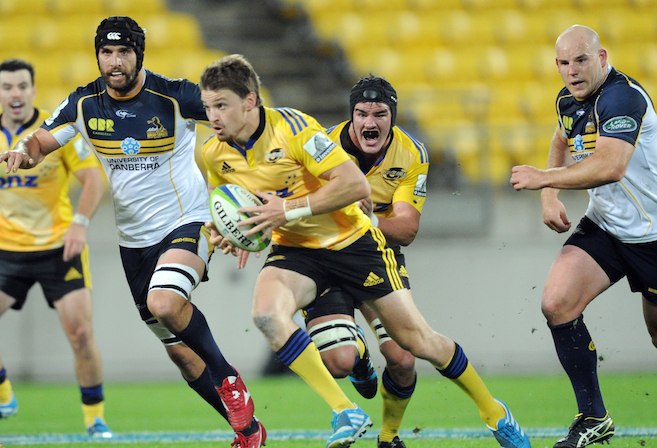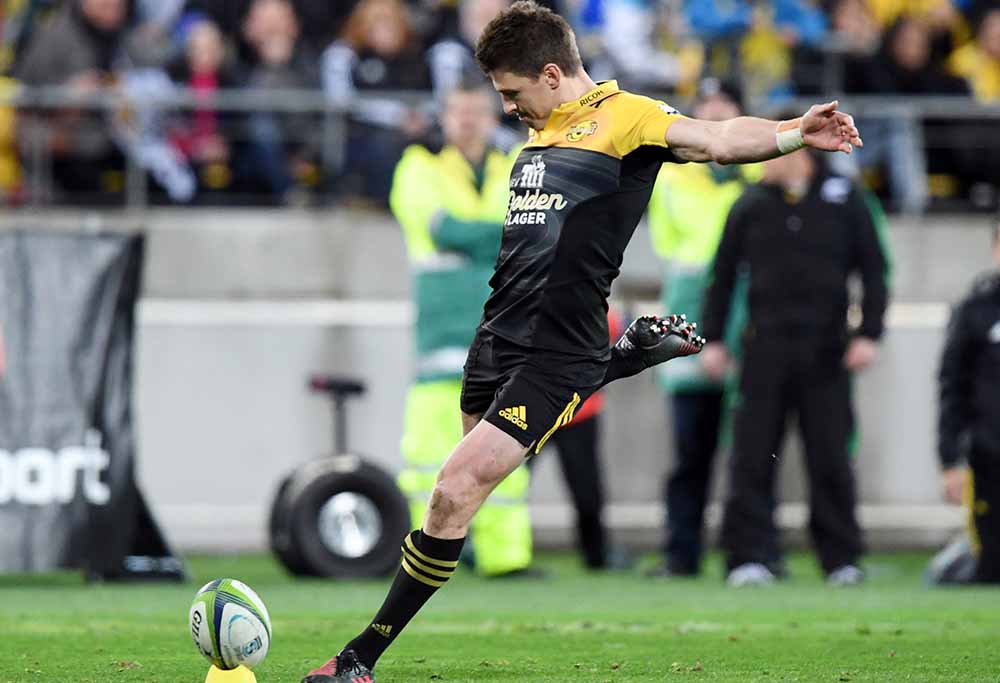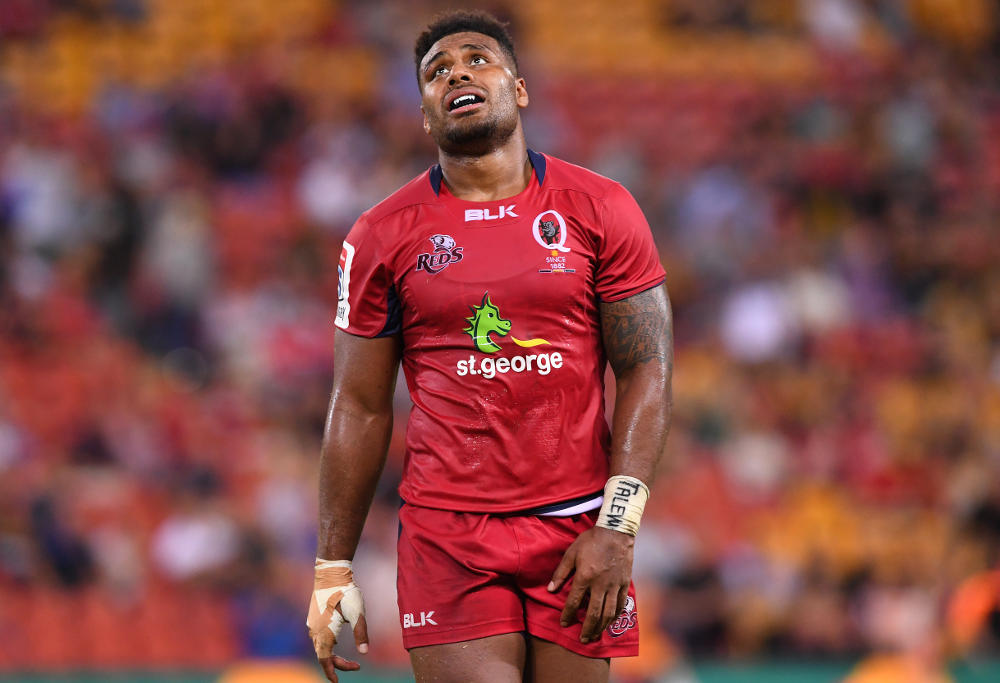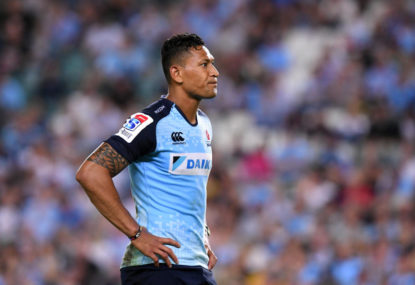The credit for the legal forward pass in gridiron football is given to Bradbury Robinson from Bellevue, Ohio. 111 years of credit should go to Beauden Barrett for virtually creating a rugby union equivalent of the gridiron football forward pass.
A deluge of Barrett kick-passes to an outside running back, in the manner of a quarterback passing to his tight ends, led to the Hurricanes smashing the Stormers 41-22 at Wellington on Friday night.
Barrett’s expert and precise finessing of the kick-pass so that it had the accuracy of a gridiron football forward pass will open a new avenue for attacking play in the rugby game.
Robinson’s forward pass in the match against Carroll College on September 5, 1906 was not completed. Barrett’s kick-passes to his wingers Cory Janes and Julian Savea and to the impressive Ngani Laumape created numerous scoring opportunities for the Hurricanes in their seven tries to one victory.
A case in point came when the Hurricanes were down to 14 men, confined to their try line and precariously leading 27–22. Barrett, with the accuracy of a Joe Montana, kick-passed to Julian Savea. After making an unexpected breakout, Savea passed to Laumape who raced away for a decisive try.
The Stormers were totally demoralised by this massive turnaround play. They failed to score another try.
I referenced Joe Montana in trying to explain what Beauden Barrett was doing with his kick-pass tactic.
The reason for this is that Barrett has enhanced the playmaking potential of the rugby number 10 by bringing the gridiron option of the forward pass into his attacking ploys with the way he uses the kick-pass option.

(Credit: SNPA / Ross Setford)
The point here is that traditionally playmakers have used the set piece for any kick-pass play. Dan Carter was a master of this. The kicker has plenty of time to put his kick-pass in from, say, a scrum. The problem with the play, though, is that defenders generally have some time to read the play and defend it.
Barrett did his kick-passing from general play. That was the innovative aspect of his play. He was like a great gridiron quarterback summing up a situation with players, on attack and defence, in motion and in the tumult of bodies running everywhere, calmly he picked out his target to hit with the kick-pass, like Montana in his prime.
Of course, there was a certain amount of planning in the tactic, even though the play was fluid and not set, with the outside Hurricane backs putting themselves in the situation where they could be running receivers.
The skills, then, came from the runners positioning themselves and crucially from Barrett perfectly weighting his kick-pass to thread the flight of the ball over immediate defenders and into the gaps out wide for the attackers to gather in and race away to set up (Savea) or score tries (Cory Jane).
The great advantage in rugby from an accurate kick-pass is that it takes the unpredictability of the bouncing ball out of the attacking equation.
With the catchers running on to the ball and with its flight being about shoulder height, there is not as much possibility of the catcher giving away a penalty going for the catch as there is with a box kick or a bomb.
The kick-through option, another alternative to the kick-pass on the run, can come off as it did frequently for the Crusaders in their massacre of the Bulls. But, as the Bulls demonstrated when they tried the tactic, the erratic, unpredictable bounce of the ball can often create chances for opponents to run away for soft tries, as David Havili did during the Crusaders historic 62–24 triumph at Pretoria.
If anyone thinks that what Barrett did was not Montana-like in its clear-eyed, nerveless skill at reading what was happening in front of him, they should look at Bernard Foley’s kick-pass attempt (which was too high and behind the catcher) to Reece Robinson (who spilled his catch) in the Waratahs–Blues match on Saturday night.

(AAP Image/SNPA, Ross Setford)
TJ Perenara, the Hurricanes’ captain, gave a shrewd assessment after the match of the smart, clinical thinking behind Barrett’s kick-pass onslaught against the Stormers
“The way they were defending, they shut down our runners in the mid-field. They had a guy in the back-field on the other side of the field to stop our kicking game. So our only real option was the cross-field kick, kicking it 20 metres was what we wanted to do.”
The result was that four of the Hurricanes seven tries came from Beauden Barrett’s kick-pass plays.
While I was watching this kick-pass clinic that Barrett was putting on, I was reminded of some deep thoughts about rugby tactics that JJ Stewart, an innovative All Blacks coach in the 1970s, expressed in his book Developments in the Field of Play.
The title of the book is unpromising, admittedly. But this essay is one of the great tomes on rugby thinking, laws and practices. There are more great ideas about the enhancing the laws of rugby and how teams could exploit the then laws in Stewart’s slim book than just about any other rugby book in modern times.
One of the fascinating passages in the book is a contemplation on the need for rugby to introduce a form of forward pass, in the Bradbury Robinson mode presumably.
Stewart argued that gridiron football was enhanced in terms of the possibilities of attacking play with the forward pass. The forward pass, essentially, tilts the balance towards the attack rather than the defence.
Stewart argued that the rugby laws were loaded against successful attacking play. The rugby laws put a thumb on the scales to weight the balance to defence. He wanted something like the gridiron forward pass brought into rugby to break up the trench warfare nature of the game in the 1970s.
The Beauden Barrett kick-pass on the run is the gridiron forward pass that JJ Stewart argued rugby needed to tilt the balance towards attack rather than defence in the rugby game.
[latest_videos_strip category=”football” name=”Rugby”]
Before Round 11 of the 2017 Super Rugby began, the New Zealand sides had defeated their Australian counterparts in all fifteen of their matches this season.
With the Chiefs defeating the Reds 46–17 in New Plymouth and the Blues defeating Waratahs 40–33 in Sydney, that shameful record of failures by Australian sides against their New Zealand rivals is now at wipeout levels.
17–0.
For the Blues, the bottom New Zealand team, their win against the woeful Waratahs was their first victory in Sydney in 14 years. The Waratahs had previously won their last seven matches in Sydney against the Blues.
The Waratahs actually scored more tries (five) than the Blues (four). But they all came in the second half when the game was virtually over.
The Blues led 26–0 at half-time. They struggled to maintain their intensity in the second half and the Waratahs scored three late tries that made the score line look much better than it really was in actuality.
As for the Reds, they were competitive – just – up to half-time when the scoreline was 20-12 against them thanks to a try after the 40 minutes were up from Damien McKenzie.
Within four minutes after the start of the second half, the Chiefs had scored and the game as a contest was effectively over.
One of the features of the game, it seemed to me, was the way the old journeyman Stephen Donald was much more effective in all aspects of play than the Reds captain Semu Kerevi who was marked so effectively that he hardly made any attacking initiatives.
Remember, too, that the Reds had been something of a bogey team in New Zealand for the Chiefs by winning their last three matches in that country.
A feature of the play of both the Waratahs and the Reds was the way they kicked the ball aimlessly away when they were under pressure and/or had run out of ideas of what to do next.

(AAP Image/Dave Hunt)
When David Horowitz kicked away a ball that went into touch on the full with his side well adrift in points, the loyal Waratahs crowd (supposedly 18,831 of them) booed the play out of despair and exasperation. And they were right to do so.
Both the Australian sides were pedestrian and lacking in ideas about how to unlock the defences of their opposition.
By way of contrast, the two New Zealand sides, and especially in the first half for the Blues when Sonny Bill Williams was on the field, were smart, inventive and direct.
It seemed to me that the Australian sides were playing draughts and the New Zealand sides were playing chess.
In draughts, the pieces can only move in a limited number of ways. This gives the game a certain lack of creativity.
This is how the Australian teams are playing their rugby right now. Take, for example, the Brumbies’ reliance on rolling maul plays.
In chess the pieces have different ways of moving, with only the pawns being limited to their range of plays. This how the New Zealand teams are playing their rugby right now, with invention, focus and continual challenges to the defence of their opponents.
The Hurricanes, for instance, unveiled the Beauden Barrett kick-pass on the run ploy and a clever new move in the front of the lineout that had their Stormers opponents flummoxed in trying to stop it.
There was a time, just before and after the year 2000, when we had the Australian teams, including the Wallabies, playing chess and the New Zealand teams for the most part playing draughts.
Mark Ella wrote a provocative column for The Australian on Saturday entitled ‘ARU needs shake-up to close the gap with Kiwis’.
He pointed out that it was “unacceptable” that two weekends ago the Brumbies, Australia’s leading side, were beaten by the Blues, New Zealand’s weakest side:
“The gulf between trans-Tasman teams is growing wider and the Australian rugby union should be concerned about the impact in terms of playing numbers, crowds, television revenue and sponsorship.”
I could not agree more. It is hard to believe how an ARU board member expressed strong views about who should be president of the Australian Olympic Committee and nothing has come from her or any other board member or the chief executive Bill Pulver on the growing gulf – now reaching Tasman Sea proportions – between the performances of the Australian Super Rugby sides in comparison with their New Zealand counterparts.
It is one thing to lose to New Zealand sides in New Zealand. But in the past, Australian sides have been very competitive against the New Zealand sides when they are playing in Australia.
We now have the ridiculous situation where the Brumbies on 18 points are leading the Australian conference and the Blues on 26 points are on the bottom of the New Zealand conference.

(AAP Image/Paul Miller)
What is worrying is that the players and the coaching staff in the Australian Super Rugby franchises seem to be brain-dead when it comes to rectifying the massive imbalance between the performances and the outcomes of their teams with their New Zealand counterparts.
And as Jamie Pandaram points out in the Sunday Telegraph, “on a miserable Saturday, South Africa’s Lions steam-rolled the Melbourne Rebels 47–10. Then the Chiefs hammered Queensland Reds 46–17 in New Plymouth, before NSW put out 40 minutes of rubbish in front of their exasperated supporters.
“At the same time, the Australian under-20s was taking on their Kiwi counterparts on the Gold Coast. New Zealand strolled home 43–6.”
The New Zealand under 20s scored six tries to none by their Australian opponents. That is the worrying aspect of the loss, not so much the loss itself. Once the ball got away from the set pieces, the New Zealanders looked like scoring on most occasions. The Australians rarely looked like scoring, aside from kicking penalties.
I come back to a point that I have been banging on about for a couple of years now. There is a massive skills deficit, on and off the field, that is poisoning the chances of success for Australian teams.
When Michael Hawker took over the chairmanship of the ARU, he and the new chief executive, Bill Pulver, allowed David Nucifora to leave the High Performance Unit and take up a similar role (with great success, it must be said) with the Ireland rugby union.
Someone of Nucifora’s stature and rugby intelligence (David Nucifora, perhaps?) needs to be brought into the High Performance Unit to bring its thinking forward to match that of the New Zealanders.
In the last two years, in particular, there has been a gap in rugby intelligence between Australia and New Zealand that is becoming a canyon. As Mark Ella notes: “Why can’t someone come up with a support structure that sets the standards to ensure the players and coaches are better prepared to face the demands of the modern game?”
That “someone” is obvious to me: Rod Macqueen, Australia’s most successful and smartest in terms of developing new plays Test coach.
Macqueen could do what Dick Marks did in the 1970s when he developed the unified coaching structures and methods throughout Australia, at every level and in every state, that led to the great eras of Alan Jones and Bob Dwyer.
How much longer can the ARU allow the rugby game to drift towards the rocks before taking some needed and obvious action to turn it around towards another era of Super Rugby and Test success?
Rod Macqueen was a great believer in the aphorism of Sun Tzu: ‘The battle is won before it is fought.’
Under a Macqueen regime, the Waratahs (unbeaten in 1991), Brumbies and Wallabies were always properly prepared to win or have a good shot at winning. That’s something that is not happening now in Australian rugby.

































































































